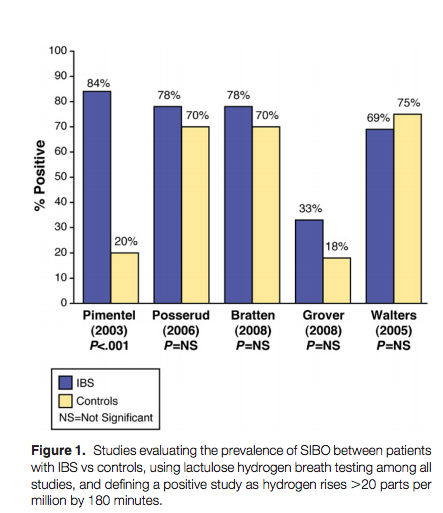Do you have SIBO? Have you heard about it? I set out to write a simple guide about which diet would help SIBO the most.
Once I got started on the science, something entirely different emerged. Please take a deep breath and sit down. Trust me, you’re in for a wild ride.
Here’s how this story started.
SIBO: A Case Study
One of my long-term patients was upset. Recently her doctor diagnosed her with small intestinal bacterial overgrowth (SIBO.)
He gave her the antibiotic Rifaximin. Along with that. a list of foods to eat and to avoid. All these steps were reasonable ones that many doctors would have taken.
After hearing the news, her encouragement grew. She had finally found the hidden cause behind her Hashimoto’s disease. It was Irritable Bowel Syndrome (IBS.)
She felt better after taking the medicine, but the benefits seemed to go away within a week of finishing it. Why didn’t they last?
Ultimately, she was afraid that maybe she didn’t do the diet correctly and did a Google search for ‘best diet for SIBO.’
At first, she saw that some of the SIBO diets were much more restrictive than the one she was following. After reading about a few more she also realized that the diets contradict one another.
Basicaly, some said that foods like walnuts, onions, broccoli, rice were safe, others said they were not.
I got involved when she sent me a note to explain her situation and to ask me about the best diet for SIBO.
The Way I Approach SIBO
I knew that SIBO experts often recommended diets. Those like the low–Fermentable Oligo-, Di-, and Monosaccharide And Polyol (Fodmaps), Specific Carbohydrate Diet (SCD), and Gut and Psychology Syndrome (GAPS).
Before I gave her any input, I wanted to be clear on which had the most compelling evidence, if any. So, I decided to look at the research.
Before I get into the findings, let me start by saying that I am open-minded. For me, I will believe absolutely anything – as long as there is evidence.
I’m also cautious. Between following my health and that of my patients, I’ve had about 38 years of seeing fads come and go. I’m not proud to say that I’ve fallen for some myself, but I am better at avoiding them.
Before I started reading the literature on SIBO, I assumed SIBO was real. I also assumed it caused symptoms, and there were effective treatments for it. When I found inconsistent research, I dug deeper and read everything I could find.
What I found shocked me and I’m not the first to see it.
We may learn more in the future that changes things. But, at this point, the story about SIBO is pretty clear.

Best Diet for SIBO
Which is the best diet for SIBO? None.
Simply put, there is no best diet for SIBO. That’s because SIBO is a failed hypothesis.
I’m going to back all of that up. First, though, let me briefly explain what SIBO is for those who aren’t clear.
What is SIBO?
SIBO stands for Small Intestinal Bacterial Overgrowth.
The ideas that associate SIBO and digestive symptoms are like those found in Irritable Bowel Syndrome (IBS).
Assumptions behind the SIBO hypothesis
- Too many bacteria in the small intestine cause intestinal symptoms
- Bacteria in the small intestine give off hydrogen and methane
- Breath tests that measure these gases can show who has SIBO
- Antibiotics that reduce bacteria improve SIBO symptoms
- Carbohydrates have unique effects on SIBO producing bacteria
- Diets that restrict foods that feed bacteria improve SIBO symptoms
Let’s go through these one by one.
Too Many Bacteria Equals Intestinal Symptoms
SIBO is defined by the number of bacteria in the second part of the small intestine. Some are normal, too many are not normal.
These bacteria can be directly measured by removing fluid from the middle of the small intestine (jejunum) with a tube.
How many bacteria are too many is a point of some debate. Most say that excess of 106 bacteria per milliliter of fluid taken from the jejunum defines SIBO.
Others say that 105 bacteria/mL is adequate for the diagnosis. Some argue that 104 bacteria/mL may be enough to cause it if they are dangerous types of bacteria.
If these bacteria cause symptoms, there should be a relationship between there. One such as how many bacteria are in the small intestine and how severe the person’s symptoms have become.
There is no such relationship.
When comparing the number of bacteria is compared to the presence or the severity of symptoms, they do not relate. Researchers found no correlation with the number of bacteria and how bad the patients’ symptoms were.1
Hydrogen and Methane
Breath tests fueled the rise of the SIBO phenomenon.
Once enough doctors started testing people, they reached a critical mass. Soon, people diagnosed with SIBO started talking. Next, others decided to get tested. Once a critical mass of people got diagnosed with it, interest peaked for treatment.
The SIBO phenomenon bases itself on the premise that hydrogen in the breath comes from the activity of bacteria in the small intestines. A few years ago, leading experts thought this was true.
On closer scrutiny, it turns out that it was never true.
The test used to diagnose SIBO does not measure SIBO. The gasses measured in the breath do not come from the activity or the number of bacteria in the small intestines.
SIBO and Transit Times
A recent study showed that the hydrogen present in breath tests is not related to the activity of small intestinal bacteria. Instead, it is a function of the transit time of the small intestine – how quickly food moves through it.
Those with SIBO have faster transit times. Food moves too quickly through their small intestine into the large intestine. Normal amounts of typical types of bacteria then generate hydrogen from this food. They create more hydrogen because food reaches them faster.
In another study, scientists took a group of 126 people with IBS symptoms and did jejunal aspirates on all of them and hydrogen breath tests on 80 of them.
They also concluded that abnormal hydrogen breath tests related to small intestinal transit time. Their work went on to show that the frequency of diarrhea could predict small intestinal transit time. It does not relate to the number of bacteria in the small intestines.
They never had too many bacteria in the small intestine.
When the number of measured bacteria came back, they also found that under 3% of those with IBS had true SIBO. There was no relationship between the number of bacteria present and the severity of symptoms.2
The idea that IBS symptoms related to abnormal transit times is not new. This mechanism is the reason why antispasmodic treatments like peppermint are often helpful.3,4
Breath Tests and SIBO
The only solid diagnosis for SIBO at the time of this writing is culture and analysis of fluid aspirated (drained) from the jejunum. Otherwise known as the second part of the small intestine.5,6
Note that this is not a procedure that is available to patients. In fact, only research centers offer it. Biopsy of the jejunal lining is a procedure that is available during an endoscopy. However, it is not as accurate.7
The most popular test in use measures the amount of hydrogen or methane in the breath. The availability of breath testing has driven the popularity of the diagnosis of SIBO and the confusion about its treatment.
Before the test, the administrator of the test gives the person tested an oral measured dose. This dose includes lactulose, glucose, xylose, or sucrose to provoke the bacteria.
Inconsistent SIBO
When people with suspicious symptoms are tested for SIBO, how many have it? The range can be as large as 4% to 78%.
What if you test people with no digestive symptoms? In healthy people, the number of ‘have SIBO’ is anywhere from 1% to 40%.8
Why are these ranges so large? It all depends on the challenge agent used, the size of the dose, the testing frequency, and what you define as abnormal.
There are many different ways the tests are done. Furthermore, none are validated as being superior to others.
There is also a high rate of random variability within the same person. One study saw that 67% of people tested get different results when retested 6 weeks later. Even though they received no treatment or dietary change.9
Other studies have shown that as many as 29% of people who fail a breath test have a normal test on a repeat without any treatment.10
What’s the best way to remedy SIBO? Just do your test over. The chances are that you’ll likely get a different result.
SIBO Tests Don’t Predict Symptoms
When comparing the same types of tests, things don’t get better.
The other assumption in the SIBO hypothesis is that SIBO tests show results that are not present in people without IBS symptoms.
This assumption is also not true.
The rate of abnormal breath tests is roughly the same in those with severe IBS symptoms as it is in control patients with no IBS symptoms.11
To restate: just as many healthy people with no digestive problems test positive for SIBO as do people with ongoing IBS.
This variance is also a problem when it comes time to see if the treatment worked or not. How can you tell when there are no clear guidelines?
You could have digestive symptoms that are not from SIBO but still have a doctor diagnose you as having SIBO. You could then go on to be treated for SIBO and be told that the treatment was unsuccessful – when you never even had SIBO.

The conclusion of a 2017 review article entitled The Clinical Value of Breath Hydrogen Testing was. “ Breath hydrogen tests contribute little value to the clinical management of patients with FBD (functional bowel disease), whether for guidance on instituting a low FODMAP diet or prescription of antibiotics for eradication of SIBO”
The next assumption in the SIBO hypothesis is that higher numbers of bacteria could cause more severe symptoms.
This statement is also false.
Antibiotics and Improve SIBO
So, let’s let go of breath testing and let go of bacteria as a cause of symptoms. Can’t we say that antibiotic therapy can reduce symptoms in those diagnosed with SIBO or IBS?
No.
If bacteria were to blame, it would be reasonable to think that antibiotics would be helpful. Even despite the shortcomings, could antibiotics still treat those with IBS symptoms?
Many with IBS have taken antibiotics and had a temporary reduction in symptoms. However, the rates of improvement have not been higher than placebo.
Once you factor in the placebo response, for every single person who improved from taking Rifaximin, ten did not get better.12
No therapies for IBS are perfect, but nearly every other current treatment studied works better than Rifaximin.13,14
The following table shows how well certain therapies worked compared to placebo. For example, if a placebo worked 30% of the time and a diet worked 40% of the time, that would yield a 10% success rate over placebo.
Therapy
Sustained-release mentha oil
*Placebo without deception
Antidepressants
Antispasmodics
Rifaximin
Success Rate Over Placebo
40%
25%
25%
20%
9%
*What is a placebo without deception? It is a placebo given openly. Researchers told patients that the pills they were taking were placebos.
The exact wording used was: “placebo pills made of an inert substance, like sugar pills, which have been shown in clinical studies to produce significant improvement in IBS symptoms through mind-body self-healing processes.”
In a randomized trial, they were shown to be helpful for a high percent of IBS sufferers.15
Just because placebos work, IBS is still real. People who suffer from it are not deluding themselves. It means that the mind has a dramatic ability to improve the underlying, likely neurologic, issues behind IBS.
Carbohydrates and SIBO
The assumption that carbs cause SIBO is behind many of the SIBO diets.
These diets specifically restrict various types of prebiotics from carbohydrates that are thought to stimulate bacterial growth.
In truth, bacteria in the small intestines do feed off of carbs. However, they also can feed off of dietary fats, bile acids, and short chain fatty acids.16
Diets that restrict foods that feed bacteria improve SIBO symptoms
Technically diets can help SIBO. But they do not work better than hypnotherapy. If there was some special effect these diets had on bacteria, hypnotherapy should not be as effective.
The most studied diet to date on SIBO symptoms is the Fodmap diet. Results have shown improvement in the 40-70% range. This sounds good until the diet is compared to placebo or hypnotherapy.
In one study, seventy-four patients were treated with hypnotherapy, Fodmap diet, or both. Improvement rate for hypnotherapy was 72%, diet was 71%, and both combined helped 73%.17
How do we know if an infection causes a disease? Researchers follow a set of principles called Koch’s postulates named after Robert Koch.
They are:
- The pathogen must be present in all cases of the disease
- It can be isolated from the diseased host and grown in pure culture
- The pathogen taken from pure culture must cause the disease when inoculated into a healthy susceptible laboratory animal
- It must be re-isolated from the new host and shown to be the same as the originally inoculated pathogen
In the case of an infection like strep throat, all these postulates apply. Everyone who has it has group A streptococcus.
A swab can be taken and grown in culture. The bacteria from the culture can infect a new host. The new host can be shown to carry the same bacteria.
More Arguments Against the Hypothesis
In the case of SIBO, none of these apply.
Further arguments against the SIBO hypothesis:
- We now know that the test that popularized SIBO never measured SIBO.
- SIBO symptoms respond to other treatments that have nothing to do with bacteria such as muscle relaxants, sedatives, and placebos.
- There is no dose-dependent relationship between SIBO bacteria counts and severity of symptoms.
- The connection between any level of SIBO and digestive symptoms is not consistent. Some studies even show that IBS symptoms make the presence of SIBO less likely.
What To Do About SIBO?
If you had no digestive symptoms but were diagnosed with SIBO please share this article with your physician. All evidence suggests that you can safely ignore this diagnosis.
If you had digestive symptoms before you were diagnosed with SIBO, please complete a proper medical evaluation to rule out Inflammatory Bowel Diseases (IBD,) celiac disease, colorectal cancer, and others.
If these are ruled out, the next step is an evaluation for the presence and subtype of IBS. I’ll talk about the diagnosis and treatment of IBS in an upcoming article.
Sources
1 – Grover M, Kanazawa M, Palsson OS, et al. Small intestinal bacterial overgrowth in irritable bowel syndrome: association with colon motility, bowel symptoms, and psychological distress. Neurogastroenterol Motil 2008;20:998–1008.
2 – Lupascu A, Gabrielli M, Lauritano EC, et al. Hydrogen glucose breath test to detect small intestinal bacterial overgrowth: a prevalence case-control study in irritable bowel syndrome. Aliment Pharmacol Ther 2005;22:1157–1160.
3 – Ford AC, Spiegel BM, Talley NJ, et al. Small intestinal bacterial overgrowth in irritable bowel syndrome: systematic review and meta-analysis. Clin Gastroenterol Hepatol 2009;7:1279–1286.
4 – Yu D, Cheeseman F, Vanner S. Combined oro-caecal scintigraphy and lactulose hydrogen breath testing demonstrate that breath testing detects oro-caecal transit, not small intestinal bacterial overgrowth in patients with IBS. Gut 2011;60:334–340.
5 – ncbi.nlm.nih.gov/pmc/articles/PMC2890937/
6 – hindawi.com/journals/grp/2015/971582/
7 – ncbi.nlm.nih.gov/pubmed/21210269
8 – ncbi.nlm.nih.gov/pmc/articles/PMC3949258/
9 – Barrett J, Ng PS, Muir J, Gibson P. Letter: oral fructose-breath hydrogen response, symptoms, both or neither? Aliment. Pharmacol. Ther. 2013; 38: 442–3.
10 – Komericki P, Akkilic-Materna M, Strimitzer T, Weyermair K, Hammer H, Aberer W. Oral xylose isomerase decreases breath hydrogen excretion and improves gastrointestinal symptoms in fructose malabsorption–a double-blind, placebo-controlled study. Aliment. Pharmacol. Ther. 2012; 36: 980–7.
11 – Walters B, Vanner SJ. Detection of bacterial overgrowth in IBS using the lactulose H2 breath test: comparison with 14C–Dxylose and healthy controls. Am J Gastroenterol 2005;100:
1566–1570.
12 – Pimentel M, Lembo A, Chey WD, et al. Rifaximin therapy for patients with irritable bowel syndrome without constipation. N Engl J Med 2011;364:22–32.
13 – Ford AC, Talley NJ, Schoenfeld PS, et al. Efficacy of antidepressants and psychological therapies in irritable bowel syndrome: systematic review and meta-analysis. Gut 2009;58:367–378.
14 – Ford AC, Talley NJ, Spiegel BM, et al. Effect of fibre, antispasmodics,and peppermint oil in the treatment of irritable bowel syndrome: systematic review and meta-analysis. BMJ 2008;337:
a2313.
15 – Kaptchuk TJ, Friedlander E, Kelley JM, et al. Placebos without deception: a randomized controlled trial in irritable bowel syndrome.PLoS One 2010;5:e15591.
16 – ncbi.nlm.nih.gov/pubmed/10235214/
17 – ncbi.nlm.nih.gov/pmc/articles/PMC5390324/

1. Schedule a Thyroid Second Opinion with me, Dr. C, Click Here for Details
2. Download and use my Favorite Recipes Cookbook Here
3. Check out my podcast Medical Myths, Legends, and Fairytales Here
Dr. Alan Glen Christianson (Dr. C) is a Naturopathic Endocrinologist and the author of The NY Times bestselling Adrenal Reset Diet, The Metabolism Reset Diet and The Thyroid Reset Diet.
Dr. C’s gift for figuring out what really works has helped hundreds of thousands of people reverse thyroid disease, lose weight, diabetes, and regain energy. Learn more about the surprising story that started his quest.


